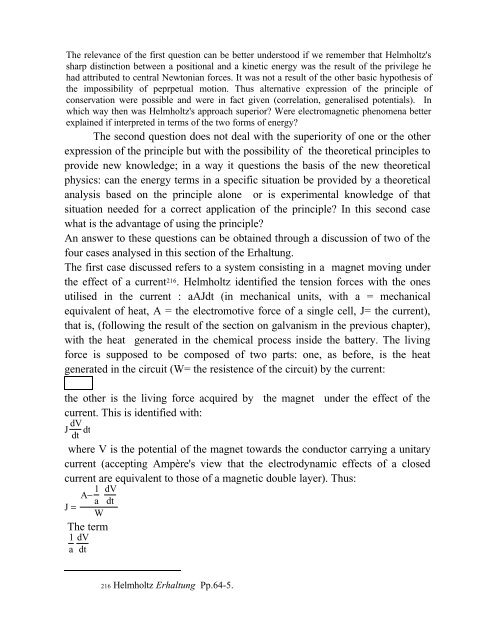Conservation and Innovation : Helmholtz's Struggle with Energy ...
Conservation and Innovation : Helmholtz's Struggle with Energy ...
Conservation and Innovation : Helmholtz's Struggle with Energy ...
Create successful ePaper yourself
Turn your PDF publications into a flip-book with our unique Google optimized e-Paper software.
The relevance of the first question can be better understood if we remember that <strong>Helmholtz's</strong><br />
sharp distinction between a positional <strong>and</strong> a kinetic energy was the result of the privilege he<br />
had attributed to central Newtonian forces. It was not a result of the other basic hypothesis of<br />
the impossibility of peprpetual motion. Thus alternative expression of the principle of<br />
conservation were possible <strong>and</strong> were in fact given (correlation, generalised potentials). In<br />
which way then was <strong>Helmholtz's</strong> approach superior? Were electromagnetic phenomena better<br />
explained if interpreted in terms of the two forms of energy?<br />
The second question does not deal <strong>with</strong> the superiority of one or the other<br />
expression of the principle but <strong>with</strong> the possibility of the theoretical principles to<br />
provide new knowledge; in a way it questions the basis of the new theoretical<br />
physics: can the energy terms in a specific situation be provided by a theoretical<br />
analysis based on the principle alone or is experimental knowledge of that<br />
situation needed for a correct application of the principle? In this second case<br />
what is the advantage of using the principle?<br />
An answer to these questions can be obtained through a discussion of two of the<br />
four cases analysed in this section of the Erhaltung.<br />
The first case discussed refers to a system consisting in a magnet moving under<br />
the effect of a current 216. Helmholtz identified the tension forces <strong>with</strong> the ones<br />
utilised in the current : aAJdt (in mechanical units, <strong>with</strong> a = mechanical<br />
equivalent of heat, A = the electromotive force of a single cell, J= the current),<br />
that is, (following the result of the section on galvanism in the previous chapter),<br />
<strong>with</strong> the heat generated in the chemical process inside the battery. The living<br />
force is supposed to be composed of two parts: one, as before, is the heat<br />
generated in the circuit (W= the resistence of the circuit) by the current:<br />
the other is the living force acquired by the magnet under the effect of the<br />
current. This is identified <strong>with</strong>:<br />
J dV<br />
dt dt<br />
where V is the potential of the magnet towards the conductor carrying a unitary<br />
current (accepting Ampère's view that the electrodynamic effects of a closed<br />
current are equivalent to those of a magnetic double layer). Thus:<br />
A−<br />
J =<br />
1<br />
a dV<br />
dt<br />
W<br />
The term<br />
1<br />
a<br />
dV<br />
dt<br />
216 Helmholtz Erhaltung Pp.64-5.
















